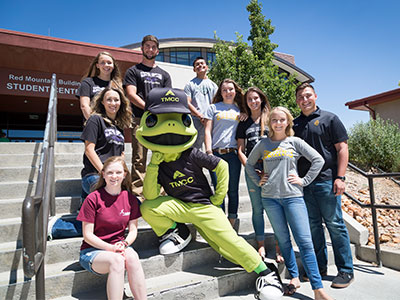
TMCC's Jump Start Program offers high school students dual enrollment opportunities.
Callee Amari enrolled in the Jump Start Program when she was a Junior at Spanish Springs High School. “I was trying to get scholarships for college, and someone mentioned that I could take college classes right now,” she said. Taking the advice seriously, she enrolled in Political Science 101 at TMCC, which stood in for her AP Government Class, and also resulted in her first three college credits. From that moment on, she was hooked. “I got a feel for how college was, what the workload was like and what to expect,” she said.
Amari realized that she could complete her Associate’s Degree if she continued to enroll in classes through the Jump Start Program through the Summer, Fall and Winter semesters. In Fall 2018, she completed the Gateway courses English 101 and Math 126, and she also earned the credits she needed to graduate from high school.
“Now I’m taking more focused classes for my degree, which will be in Molecular Biology and Immunology.” Amari, who plans to continue her education at the University of Nevada, Reno, is grateful for the opportunities offered by the JumpStart program. “It helped me realize what I really wanted to do. I always knew I wanted to go to medical school, but that will take twelve years. It’s nice to know I saved myself two years on that journey.”
Dual Enrollment: What the Research Says
Dual enrollment—taking courses that simultaneously count for high school and college credit—is a relatively new practice that, according to the data, shows promising outcomes for students. A study conducted by a team of researchers from Northeast State Community College and East Tennessee State University uncovered some interesting findings of dual-enrolled students:
- Community college students who took dual enrollment courses in high school were 9 percent less likely to require remedial help than those who did not.
- More than 30 percent of students who had been dually enrolled completed an associate degree on time.
- Forty-six percent of students who were dually enrolled earned associate degrees within three years, compared to 33 percent of those who were not.
While several studies have analyzed the benefits of dual enrollment programs, the key need solved by dual enrollment is that it gives young students an opportunity to learn the specialized demands of college sooner than those who pursue a more traditional route to post-secondary education.
These skill sets can be particularly useful for students from smaller schools or who come from a homeschool environment where they may not have had to advocate for themselves in the way that you have to in higher education. While all high school students are sure to face challenges (the expectation of a higher quality of work, the risk of ending up with a poor grade), dual enrollment is an opportunity for young students to not only learn the content of the courses they take, but (more importantly) how to be successful college students. This means they are more likely to be successful sooner than peers who were not participating in a dual enrollment program.
Cost Savings
Aside from documented academic gains, pursuing dual enrollment has considerable cost-saving benefits, too. For Nevada residents, TMCC’s dual enrollment classes are offered at a 25% discount for in-person classes, which is less than half the cost of a course at a four-year institution like UNR. Our online course options cost $50 (plus a tech fee, online fee, student association fee and health center fee) per class—which is something to consider when, most times, you will pay more than that amount per credit.
Besides saving money on tuition, dual enrollment students take less time after high school to finish a college degree. And, with access to resources on campus (the library, the counseling center, academic advisement) students can literally “jump-start” their college experience.
How Can I Become a Dual Enrollment Student?
If you want to earn college credit for a fraction of the price while you complete your high school education, you have to meet a few requirements: if you’re a senior, you need a 2.5 GPA or above (for juniors and below, you need a 3.0 GPA or higher); you must also meet the prerequisites of the classes in which you enroll.
Additionally, admission is for one semester only—so you will have to reapply by completing this admission form and this permission to enroll form every semester you want to take dual enrollment courses.
If you meet the basic requirements, check out our Steps to Enroll for Jump Start Students to get started!
Available Classes
There are several offerings for dual enrollment options for this upcoming semester. Hybrid courses - which are open to all high school students - are currently offered at TMCC’s Meadowood Center:
- English 101: Dates: 01/28/2019–05/15/2019; Times: Fri 1:30–2:45 p.m.
- English 102: Dates: 01/28/2019–05/15/2019; Times: Wed 1:30–2:45 p.m.
- Math 126: Dates: 01/28/2019–05/15/2019; Times: Tues 1:30–2:45 p.m.
At Sparks High School, students have the opportunity to attend the following courses for dual credit:
- ELM 110 Electrical/Electronic Circuits: Dates: 01/15/2019—01/24/2019; Times: Tu/Th 2:45–4 p.m.
- OSH 222 General Industry Safety: Dates: 01/15/2019—01/24/2019; Times: Tu/Th 2:45pm–6:45 p.m.
The following “Magnet” course—open to all high school students—is taught at TMCC’s Applied Technology Center. In addition to required class times, participating students must attend a mandatory orientation on Tuesday, Jan. 22 from 3-5 p.m. at the Applied Technology Center.
- ELM 110 Electrical/Electronic Circuits: The class also includes mandatory progress meetings on 2/12/19, 3/12/19 and 4/16/19, in addition to a weekly commitment of three hours of lab time. You will also need to complete all assigned online work.
For more information on your options for dual enrollment at TMCC, contact the Jump Start Program, which is co-located with the Access, Outreach and Recruitment Office at 775-673-8236.






